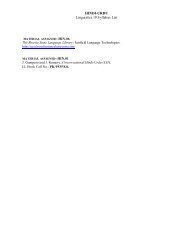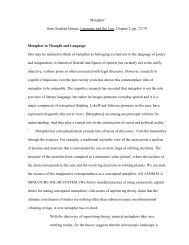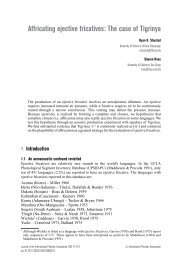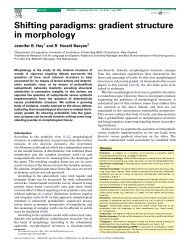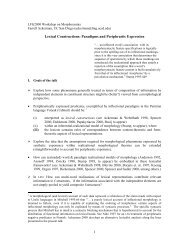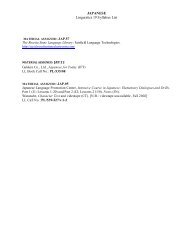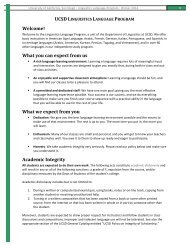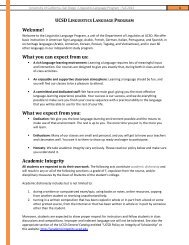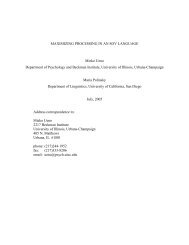The morphological structure of the Moro verb Sharon Rose
The morphological structure of the Moro verb Sharon Rose
The morphological structure of the Moro verb Sharon Rose
You also want an ePaper? Increase the reach of your titles
YUMPU automatically turns print PDFs into web optimized ePapers that Google loves.
<strong>The</strong> <strong>morphological</strong> <strong>structure</strong> <strong>of</strong> <strong>the</strong> <strong>Moro</strong> <strong>verb</strong><br />
(10) H-H pattern H-L pattern<br />
a. g-ʌ-sʌ́ð-ʌ́ defecate f. g-a-tóð-a move<br />
b. g-a-wáð-á poke g. g-a-váð-a shave<br />
c. g-a-nát ̪-á taste h. g-a-sát ̪-a chew<br />
d. g-a-ɾát ̪-á clear land after harvest i. g-a-rát ̪-eə kneel<br />
e. g-a-boáɲ-á like, want j. g-a-noán-a watch<br />
Ano<strong>the</strong>r group <strong>of</strong> consonant initial <strong>verb</strong>s begins with a closed syllable, closed<br />
by a nasal, an r or a geminate consonant. In <strong>the</strong>se cases, H tone is restricted<br />
to <strong>the</strong> closed syllable and does not extend beyond it to <strong>the</strong> following syllable.<br />
<strong>The</strong>re are no exceptions to this pattern that we have found.<br />
(11) HL pattern with CVCCVC or H-L pattern with CVCC roots<br />
a. g-a-mʷándəð-eə ask g. g-a-wárð-a write<br />
b. g-a-wəńdat ̪-a see h. g-a-várt ̪-a lead, be in front <strong>of</strong><br />
c. g-ʌ-vəńdəɲ-a snap, break i. g-a-lánd̪-a close<br />
d. g-a-lálːəɲ-a run j. g-ʌ-t̪únd̪-ʌ cough<br />
e. g-ʌ-lʌ́lːʌð-iə scatter k. g-a-mórʧ-a take from<br />
f. g-a-ʧómbəð-a tickle l. g-a-kárm-a find guilty and fine<br />
Finally, <strong>the</strong>re is a group <strong>of</strong> consonant-only <strong>verb</strong> roots. As <strong>the</strong>re is no root<br />
vowel that can bear H tone, <strong>the</strong>se are all low-toned forms.<br />
(12) C-only roots – no H tone<br />
̪<br />
a. g-a-mː-a take d. g-ʌ-pʷː-ʌ beat<br />
b. g-a-rː-a kick (once), pound, stab e. g-ʌ-tː-iə drink<br />
c. g-a-sː-a eat<br />
Vowel-initial roots show a different tone pattern from <strong>the</strong> consonant-initial<br />
roots. Most vowel-initial roots with two vowels have a H tone only on <strong>the</strong><br />
second vowel. This H tone does not extend to a following suffix.<br />
(13) LH pattern – V-initial <strong>verb</strong> roots<br />
a. g-oɡə́t-a jump d. g-abə́t ̪ʷ-a climb<br />
b. g-obə́ð-a run away e. g-udʌ́ð-ʌ milk<br />
c. g-ʌwút ̪-ʌ drop f. g-abátʃ-a lift<br />
Recall that <strong>the</strong> clause marker a-, which marks finite clauses and normally<br />
precedes <strong>the</strong> root, is deleted by a regular hiatus process in which <strong>the</strong> first <strong>of</strong><br />
two adjacent vowels deletes.<br />
Vowel-initial roots that are <strong>of</strong> <strong>the</strong> shape VC have no H tone:<br />
7




